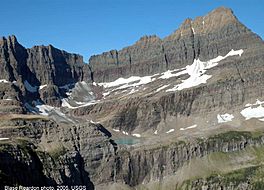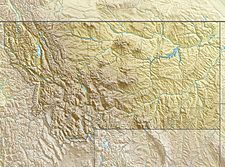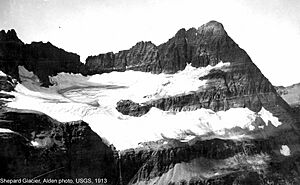Shepard Glacier facts for kids
Quick facts for kids Shepard Glacier |
|
|---|---|

Shepard Glacier as photographed in 2005
|
|
| Type | Glacieret |
| Location | Glacier National Park, Glacier County, Montana, U.S. |
| Coordinates | 48°51′56″N 113°51′32″W / 48.86556°N 113.85889°W |
| Area | Less than 25 acres (0.10 km2) in 2009 |
| Terminus | Talus |
| Status | Retreating |
Shepard Glacier is a small piece of ice, also known as a glacieret, located in Glacier National Park in Montana, U.S. It sits right next to Cathedral Peak. This glacier is one of many that scientists have been watching closely because it has been shrinking a lot over the years.
Contents
What is Shepard Glacier?
Shepard Glacier is not a huge, flowing river of ice like some glaciers. Instead, it is a "glacier remnant," which means it's a small leftover piece of a larger glacier that used to be there. Scientists sometimes call these tiny glaciers "glacierets."
Where is Shepard Glacier Located?
This small glacier is found in the beautiful Glacier National Park in the state of Montana. It is specifically located in Glacier County, Montana. You can find it just southeast of a mountain called Cathedral Peak.
How Shepard Glacier is Changing
Scientists from the United States Geological Survey (USGS) have been studying glaciers in Glacier National Park for many years. They have seen that many of these glaciers, including Shepard Glacier, are getting much smaller. This process is called "retreating."
Measuring the Retreat
In 2009, scientists measured Shepard Glacier. They found it had shrunk to less than 25 acres (0.10 km2). This size is considered very small for something to still be called an active glacier. Between 1966 and 2005, Shepard Glacier lost more than half of its surface area. To be exact, it lost 56 percent of its ice cover.
Seeing the Change Over Time
You can really see how much Shepard Glacier has changed by looking at old and new photos. The picture in the infobox at the top of this page shows the glacier in 2005. If you compare that to the image below, which was taken in 1913, you can clearly see how much the glacier has shrunk over those years.



